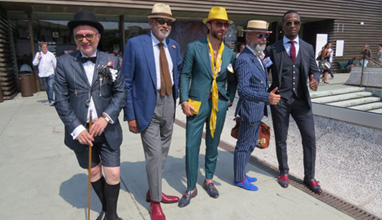The perfectly fitting handmade Gieves & Hawkes men's suit
The window of Gieves & Hawkes is especially representative for Savile Row. Often the best tailors are in the smallest stores, but that's not the case with Gieves & Hawkes at 1 Savile Row, London, UK.

It resided in rooms that once belonged to the Royal Geographical Society as their main headquarters. A new customer is led upstairs in the Adam Room. There, in an excited atmosphere, are put the bases of most probably decades of trusting relationship between a client and a cutter. While the customer talk about his manners an habits and presents his preferences about the cut and the fabrics, the cutter is carefully listening and outlines in general terms the figuration of the described suit.


The experienced cutter doesn't need a lot of time to understand what the customer wishes, even if he himself is not completely sure what he wants. After the cut and the details are clear, the client choose the preferred fabric under the careful guidance of the expert. While taking gentleman's measurements, the cutter use a discrete code. DRS means dropped right shoulder; FS - forward stomach; BL 1, 2 or 3 - bowed legs to the first, second or third degree.
Tired of ready-to-wear garments the client understands for the first time that he shouldn't excuse himself for the imperfections of his body and shouldn't be punished for this with a ill-fitting suit. Even if he has a bigger stomach or a poorly shaped backside, his trousers will fit optically perfect.


When taking measurement for trousers, the cutter asks if the client prefers wearing a belt or suspenders, because this defines the length of the legs.
Upon the taken measurement and the improved with the years sense of the cutter, the cut of the garment is outlined on a rough paper. The cut is the building plan of the suit. The separate parts are cut and combined to form a template. Then the templates are sketched with chalk on the fabric. Everything is cut by hand. Sewing of the parts is made by hand and mainly with white cotton thread by a coat maker, a trouser maker and a vest maker for the first fitting. Theoretically it could take place in a few days, but as tailors are overwhelmed with orders, the first fitting usually happens in a few weeks.
During it, the client sees his suit for the first time out of his imagination and together with the tailor decided if any alterations are needed. After that the suit goes back to the coat maker, who created a second version with all improvements.
All pads made of canvas, cotton, felt or horsehair - which in ready-to-wear are glued because it's faster - are extremely carefully hand-stitched.
Through ironing, the pads are pressed to the wished shape, which gives a 3D frame of the suit.
Buttonholes are necessarily made by hand with silk threads. The final hand ironing gives a suit his ultimate shape and it must resist to all sorts of dry cleaning.
Then comes the last fitting and - if all of the customer's wishes are satisfied - the work on a suit is finished. If on the street the ready suit looks like a brand new, this is not a compliment for the tailor and the customers has the right to go to another legendary institution on Savile Row - Anderson & Sheppard.
And that, ladies and gentlemen, means that the suit needs to look... as if you were born with it, whatever that means...


And what can we say about the uniforms, which Gieves & Hawkes make for the British heir to the throne?
Photos: Gieves & Hawkes
Hits: 7550 | Leave a comment



















